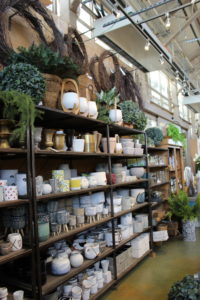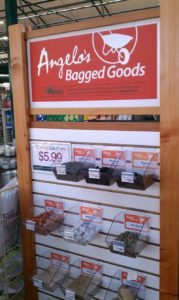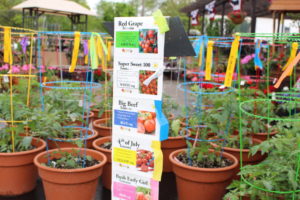Tools Of The Trade
Whether they are avid gardeners or new homeowners just learning about the joys of tree, lawn and plant care, most garden center customers know that having the right tools makes the job easier. And while consumers are likely to collect many tools over the years, their starter sets nearly always contain the same instruments: a pruner, lopper, pruning saw, leaf rake and round-point shovel. In other words, there are five tools every garden center should have available regardless of floor space or inventory constraints.
Pruning Tools
It is a good idea to carry an assortment of pruning tools for your customers: Each gardener will need a tool to cut stems and small branches, another to cut thicker branches and one to cut larger tree limbs. Therefore, your garden center’s collection of pruning tools should include pruners, loppers and pruning saws.
Pruners. A pruner is a 1-handed tool ideal for cutting green growth with up to a three-fourth inch diameter. Ergo-nomics is the mantra for 21st-century gardeners, as carpal tunnel syndrome, tendonitis and even arthritis are the scourge of modern-day green thumbs young and old. It is vitally important to suggest and have tools that help reduce stress and strain when performing repetitive movements such as pruning and deadheading.
Flexing the hand up and down while cutting creates skin friction and tendon stress that results in fatigue and possible injury. Look for hand pruners designed with angled blades that keep the wrist and hand straight and level, which reduces stress on the hand, wrist and arm. You may also want to choose a pruner with a “mechanical advantage,” such as rotating and/or spring-loaded handles.
Loppers. Loppers have longer handles and bigger blades than hand pruners. The longer handles provide more leverage, which allows users to cut larger branches up to 2 inches thick. They also extend reach by a foot or two. Again, be sure to recommend loppers with a mechanical advantage, such as multiple pivot points. Think gears or levers mechanisms designed to increase leverage and maximize cutting power. You may also want to suggest those with lightweight, tubular steel, aluminum or fiberglass handles fitted with comfortable grips.
Pruning Saw. Customers looking to cut branches thicker than 2 inches will need a heavy-duty cutting tool. A pruning saw is ideal for such tasks. Unlike saws used for woodworking, most pruning saws are uniquely designed to slip into tight spots; they are often curved for more ergonomic cutting of rounded branches. The handles are also more comfortable on the hand and less wearing to the arm. Look for saws that cut both with pull and push strokes for fastest cutting.
Maintenance Tool
If you own a home and have even the slightest bit of yard, you know that a leaf rake is essential for gardeners, especially in the fall!
Much can be taken into consideration when choosing what kind of rake(s) to have on hand. Once again, ergonomic enhancements come into play. Specifically, rakes with longer handles actually improve posture, thus reducing back strain and fatigue. Other ergonomic enhancements include specially shaped handles or a rubber grip, both help prevent hand fatigue and blisters.
A rake’s construction materials should also be considered. Rakes come in a wide variety of sizes and designs. The heads may be constructed of bamboo, metal or plastic. Bamboo tines can dry out and snap off over time. (An occasional soaking can reduce brittleness.) Steel tines are sturdy, but they can bend and become misshaped. For consumers, suggest plastic tines with a bit of flex and a gentle curve rather than a 90° angle. These types of rakes help prevent leaves, twigs and other debris from getting stuck. They also move more tenderly over live growth, leaving it in tact and healthy.
Rake heads may be fan shaped or rectangular. Rectangular heads provide a larger surface area in which to collect and move leaves. They also provide better scooping ability as fewer leaves can slip over the narrow part where a fan-shaped head meets the handle.
Digging Tools
A shovel is probably one of the most important tools a garden center customer needs when taking on any large or small landscape project. It is used for digging holes and moving soil, compost or mulch.
The common perception is all shovels look the same; but, if you take a closer look, you will notice that is not necessarily the case. Be sure to look for shovels with pre-sharpened blades. Most consumers do not know that to be the most effective, the blade should be sharpened. A pre-sharpened blade allows them to begin work immediately with a tool that slides easily into the ground and cleanly cuts roots. It also provides the proper bevel to follow when the item needs sharpening again.
Shovels with ergonomic enhancements such as longer, specially shaped shafts and extra-wide, D-shaped handles are sure to garner some attention. Such enhancements provide a stronger, more comfortable grip as well as less fatigue and improved handling of heavy loads. They should also look for an enlarged step area, which provides more control and comfort underfoot, especially with lengthy digging tasks.
The materials from which and how a shovel is constructed should also be considered. The blades of shovels and spades can be constructed with open or closed backs. The open back is the more common style. The blade is stamped out of a single sheet of metal, and the back of the socket is left open to be fitted around the handle. This method of construction requires a crimp (the frog) on the face of the blade below the socket to provide additional rigidity. The back of the blade is correspondingly hollow at this point.
The closed back is sturdier; the blade is so strong that no reinforcing frog is required. This type of shovel is often made out of high-carbon steel or steel and manganese for greater strength. The gauge is a measure of metal thickness: The smaller the number, the thicker the tool. Handles are typically available in wood, steel and fiberglass. Steel handles are often preferred as they withstand the heaviest jobs best.
There are two basic shovel blade types:
Round-point blade. This blade type features a rounded blade that comes to a slight point. It is most commonly used for heavy-duty digging, such as preparing planting holes or removing sod and soil for a walkway or garden bed.
Square-point blade. This shovel has a straight blade with squared-off corners. It is used for scooping or transferring materials such as mulch, sand and loose soil rather than for digging.
There are also two basic shovel-handle types:
Long handle. Long and straight, this type is most commonly used for digging.
D-handle. D-shaped handles are often preferred for scooping and moving material from one place to another.
Having The Right Products
A “starter set” of tools for the new homeowner or fledgling gardener is an important first step and pruners, loppers, pruning saws, rakes and shovels are the most likely tools to make up that set. Having the right products on hand in your garden center and getting that customer off to a good start with a reliable set of tools and valuable advice could be the foundation for a lifelong passion and a long-lasting relationship.
















 Videos
Videos





